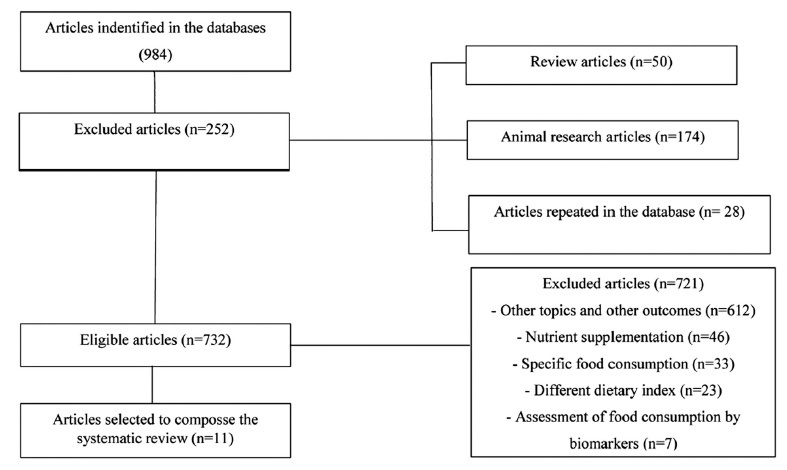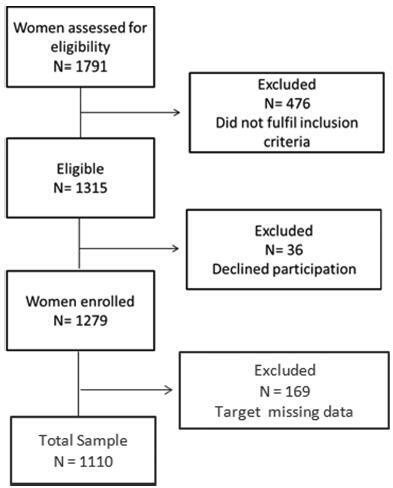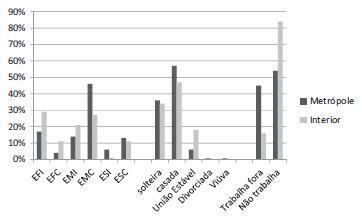Summary
Revista Brasileira de Ginecologia e Obstetrícia. 2022;44(5):540-547
The present systematic review (PROSPERO: CRD42020148630) hypothesizes the association of excessive weight gain during pregnancywith dietary patterns composed of ultraprocessed foods. Thus, the objective was to investigate the association between dietary patterns after analysis and weight gain during pregnancy. The search for articles was performed in nine databases. Two reviewers selected the articles in the databases and extracted from them the data used in the review. Two scales were used to evaluate the quality of the selected studies: New Castle-Ottawa Quality Assessment for cohort-based studies and Appraisal tool for Cross-Sectional Studies (AXIS) for cross-sectional-based studies. In total, 11 studies were identified with sample size variation (n=173-5,733). Women presenting more adherence to healthy and traditional patterns (fruits, vegetables, salads, nuts, and dairy) recorded less excessive gestational weight gain (GWG). Higher intake ofmixed patterns and western patterns rich in ultraprocessed foods were associated with a higher prevalence of excessive GWG (24.48- 55.20%). Gestational dietary patterns a posteriori-derived that have presented ultraprocessed components rich in fat and sugars presented association with high GWG; healthy and traditional dietary patterns were related to better mother-child health conditions, such as adequate GWG.

Summary
Revista Brasileira de Ginecologia e Obstetrícia. 2019;41(8):469-475
The aim of this study was to investigate the knowledge concerning gestational weight gain (GWG), nutrition, and physical exercise (PE) in pregnant women, and how to put them into practice.
A cross-sectional study with 61 pregnant women above 26 weeks of gestation, at the Woman’s Hospital, CAISM, University of Campinas. Questionnaires regarding the knowledge of healthy habits (HH) during pregnancy, sociodemographic data, and previous obstetric outcomes were applied. An educational guide with advice on HH during pregnancy and in the postpartum period was offered.
The average age of women was 28.7 ± 6.23 years, with 85% of them being married; 32% nulliparous; the average body mass index (BMI) before pregnancy was 25.4 ± 9.8 kg/m2, and themean number of years of schoolingwas 11.2 ± 3.8. Only 61%of the subjects had received any previous information about GWG during their antenatal care and were aware as to howmany pounds they should gain during pregnancy. Among the 61 women, 85% understood that they did not need to “eat for 2” and 99% knew that PE had benefits for their body and was safe for their baby. Half of the women practiced PE prior to pregnancy; however, only 31% continued the practice of PE during the pregnancy.
Despite understanding the need for HH during pregnancy, women still need encouragement to practice PE during pregnancy, as well as more information about GWG.
Summary
Revista Brasileira de Ginecologia e Obstetrícia. 2018;40(1):11-19
To evaluate the relation between changes the body mass index (BMI) percentile, reflected in the Atalah curve, and perinatal outcomes.
A cross-sectional study with 1,279 women was performed. Data regarding gestational weight, sociodemographic characteristics and perinatal outcomes were collected through medical charts, prenatal card and interviews in the postpartum period. Women could be classified according to the Atalah curve in the following categories: low weight, adequateweight, overweight, and obese. The BMIwas calculated at the first and at the last prenatal care visits, and these values were compared.
An increase in the BMI category according to the Atalah classification occurred in 19.9% of pregnant women, and an increase of 3.4, 5.8 and 6.4 points of BMI were found for women respectively classified in the adequate weight, overweight and obese categories at the first prenatal visit. Women with high school education presented a lower chance of increasing their BMI (odds ratio [OR] 0:47 [0.24- 0.95]). Women who evolved with an increase in the the Atalah classification were associated with cesarean section (OR 1.97-2.28), fetalmacrosomia (OR 4.13-12.54) and large for gestational age newborn (OR 2.88-9.83).
Pregnant women who gained enough weight to move up in their BMI classification according to the Atalah curve had a higher chance of cesarean section and macrosomia. Women classified as obese, according to the Atalah curve, at the first prenatal visit had a high chance of cesarean section and delivering a large for gestational age newborn.

Summary
Revista Brasileira de Ginecologia e Obstetrícia. 2016;38(1):27-34
To determine differences in some nutritional aspects of pregnant women assisted at prenatal care services in a country town and in a metropolitan area.
Pregnant women received prenatal care in the city of Belo Horizonte (BH), metropolitan area, and Paula Cândido (PC), a country town. A Food Frequency Questionnaire (FFQ) containing socioeconomic information and information about eating habits was applied. In addition,weight and height were measured on the occasion of the visits and the women were ask to give their prepregnancy weight for subsequent BMI calculation. Data were analyzed according to region and trimester of pregnancy using the SPSS software version 15.0, the t-test to compare averages and the chi-square test of independence, with the level of significance set at 5%.
240 pregnant women were included, 90 fromthe country town and 150 from themetropolitan area. Of these,most weremarried (BH = 56.6%; PC = 46.6%) and did not work outside the home (BH = 54.0%; PC = 84.4%). They predominantly had 3-4 meals/ day during the 1st and 2nd quarters (BH = 54.0 and 46%; PC = 66.7 and 63.3%, respectively) and had 5-6 meals/day during Q3 in BH (44%). There was significant weight gain only in the 1st quarter (BH: 58,0%; PC: 53.3%). Weight gain versus eating habits was significant for the variables "lunch or dinner away from home" for the 1st quarter in BH (p = 0.006), "How many times they consume milk" in the 1 st quarter in PC (p = 0.03), and "How many times they consume junk food" in the 3rd quarter in BH (p = 0.009).
Pregnant woman showed proper eating habits in both regions despite the prevalence of pregestational overweight in BH and a low level of education and income, especially in the country town, an indicator that may be unfavorable for the nutrition of pregnant women during this period. Studies of association between eating habits and newborn health will provide more information about nutrition during pregnancy.

Summary
Revista Brasileira de Ginecologia e Obstetrícia. 2014;36(7):320-327
DOI 10.1590/SO100-720320140004998
Apresentar a adaptação transcultural para o português da Escala de Atitudes em Relação ao Ganho de Peso na Gestação.
Essa escala, que contém afirmações que expressavam diferentes atitudes de gestantes em relação ao seu próprio ganho de peso, foi desenvolvida para determinar se as atitudes em relação ao corpo afetariam o ganho de peso durante a gestação. Os procedimentos foram: tradução, retrotradução, avaliação da compreensão, elaboração de versão final, aplicação da escala em 180 gestantes (média 29,6 anos e idade gestacional 25,7 semanas) e análise psicométrica.
Constatou-se equivalência satisfatória entre as versões inglês-português e boa consistência interna (Alpha de Cronbach 0,7). A análise fatorial exploratória sugeriu quatro subescalas com variância total explicada de 51,4%.
A escala se demonstrou válida e pode ser utilizada em estudos com gestantes no Brasil para avaliação de atitudes em relação ao ganho de peso e detecção e prevenção de comportamentos disfuncionais durante a gestação.
Summary
Revista Brasileira de Ginecologia e Obstetrícia. 2014;36(7):320-327
DOI 10.1590/SO100-720320140004998
To present the cross-cultural adaptation to Brazilian Portuguese language of the Pregnancy and Weight Gain Attitude Scale.
This scale was developed in order to verify whether attitude toward thinness affects weight gain during pregnancy and contains statements that express different attitudes of pregnant women regarding their own weight gain. The procedures were: translation, back translation, comprehension evaluation, preparation of a final version, application of the scale to 180 pregnant women (mean age=29.6, gestational age=25.7 weeks) and psychometric analysis.
Satisfactory equivalence between the versions and satisfactory internal consistency (Cronbach's alpha 0.7) were detected. The exploratory factor analysis suggested four subscales with 51.4% total variance explained.
The scale proved to be valid and can be used in studies with pregnant women in Brazil to assess attitudes toward weight gain and to detect and prevent dysfunctional behaviors during pregnancy.
Summary
Revista Brasileira de Ginecologia e Obstetrícia. 2013;35(12):536-540
DOI 10.1590/S0100-72032013001200002
PURPOSE: To evaluate weight retention 12 months postpartum and factors associated among women who had received prenatal care at Health Care Centers in Porto Alegre, southern Brazil. METHODS: Pregnant women in the last trimester were identified at 20 Health Care Centers. Socioeconomic, demographic and anthropometrics data were obtained. Six and 12 months after delivery, the women received home visits for anthropometric measures. The gestational weight gain was defined by pre-pregnancy Body Mass Index (BMI). Weight retention was defined as the difference between pre-gestational weight and weight at postpartum. Data were analyzed using McNemar's Test, ANOVA with Bonferroni correction and multiple linear regression. RESULTS: Of the 715 pregnant women recruited, 545 were assessed 12 months after delivery. Women were more likely to be overweight 12 months postpartum compared to the pre-pregnancy period (52.9 versus 36.7%) and weight retention during the 12 months postpartum was more than 10 kg in 30.7% of the women. Weight retention in the postpartum period was higher among women who were overweight (9.9±7.7 kg) compared to those who were of normal weight during the pre-pregnancy period (7.6±6.2 kg). Pre-pregnancy BMI, gestational weight gain, and maternal age were associated with gestational weight retention 12 months postpartum (p<0.001). CONCLUSION: Adequate prenatal care is necessary to minimize the adverse effects of excessive weight gain during pregnancy on women's health.
Summary
Revista Brasileira de Ginecologia e Obstetrícia. 2013;35(11):523-529
DOI 10.1590/S0100-72032013001100008
PURPOSE: To evaluate the adequacy of gestational weight gain and to determine its association with maternal socioeconomic, demographic and nutritional factors and health care, to estimate the prevalence of low birth weight, macrosomia, preterm birth and cesarean delivery and to identify the association of these outcomes with the adequacy of weight gain. METHODS: A cross-sectional study was performed in 2009/2010 to obtain socioeconomic, demographic, nutritional, dietary and physical activity data of pregnant women assisted by primary health care in a municipality of the state of São Paulo. Subsequently, data were collected from the medical records to evaluate gestational weight gain. Type of delivery, birth weight and gestational age at delivery were obtained from the Livebirths Information System. Gestational weight gain was evaluated according to the recommendations of the Institute of Medicine (2009). Associations were investigated by comparing the frequencies and by logistic regression, with excessive weight gain (yes, no) and insufficient gain (yes, no) being the dependent variables. RESULTS: A total of 212 pregnant women were studied: 50.5% had excessive gain and 19.8% insufficient weight gain. Only prepregnancy nutritional status was associated with adequacy of weight gain: compared with normal weight, prepregnancy overweight women had a four-fold higher chance to gain excessive weight (OR 4.66, 95%CI 2.19-9.4). Nearly a third of babies were born by caesarian section, 5.7% were premature, 7.1% were underweight and 4.7% were macrosomic. There was no association between adequacy of gestational weight gain and these outcomes. CONCLUSION: The proportion of inadequate gestational weight gain was high. Overweight pregnant women have a four-fold higher chance to gain excessive weight, and priority should be given to actions promoting adequate prenatal weight gain.